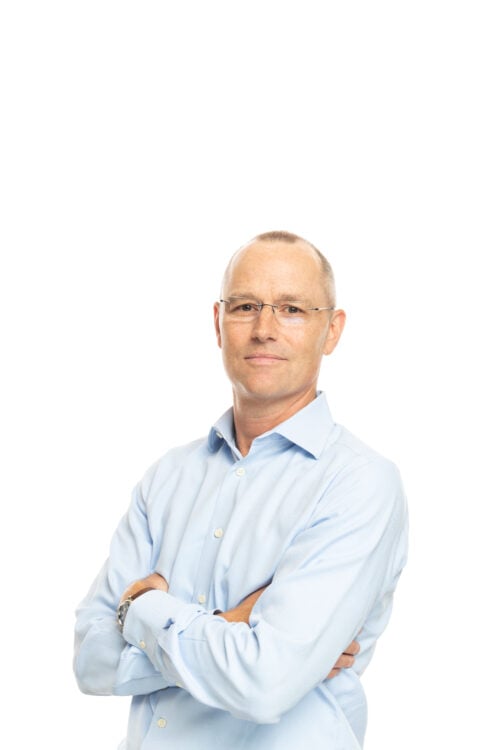Celebrating One Year of Creating a Better Future for Kidney Patients
In our first year, we've grown our physician network, improved clinical outcomes, and reduced costs for our payer partners.
tags

August marked Interwell Health’s one-year anniversary. In our first year, we worked alongside a growing community of payer and provider partners to achieve results that directly improve the lives of kidney patients. Our Chief Executive Officer, Robert Sepucha, joined the Finn Voices podcast to reflect on this milestone and share plans for the future. The edited interview appears below.
Q: Interwell recently celebrated its first anniversary. Can you tell us why these three companies came together?
RS: Interwell Health was formed in August 2022 when Fresenius Health Partners, Cricket Health, and legacy InterWell Health came together as a single entity with the mission to reimagine kidney care and create a better future for all kidney patients.
We recognized that together, as one company, we could be the connective tissue between the kidney and dialysis centers and the other providers, like primary care and cardiologists, to help make it easier for patients to navigate a very complex disease and a very complex healthcare system. We partner with private and government payers to manage their kidney disease patients, taking full clinical and financial responsibility. And we’ve proven the ability to deliver better outcomes for these patients, while reducing the total cost of care.
As much success and growth as we have seen in this first year, we continue to move forward, at speed, to expand our scope of resources.

Recently we acquired Acumen Physician Solutions, providers of electronic health record and patient management software for nephrologists, which helps create a better value-based care experience for our providers and patients.
Q: What are some of Interwell’s big accomplishments in kidney care over its first year?
RS: In our first year, we added almost 100 nephrologists to our network, bringing our total to 1,700 physicians supporting patients across the country. And we now cover 125,000 lives.
We’ve also demonstrated remarkable results for patient health, including an optimal start rate that is 154 percent above the national average, a home dialysis start rate that is 87 percent above the national average, and an almost 20 percent reduction in all-cause hospitalizations. These improved clinical outcomes have driven significant financial savings for payer partners in full risk contracts.
To expand our ability to transform kidney care, we collaborated with a number of provider and payer organizations. For example, Interwell created Oakwell, a joint venture with Oak Street Health, a network of value-based primary care centers based in Medicare, to offer primary care to end-stage kidney disease patients directly in the dialysis center.
On the payer side, we partnered with Providence Health Plan on a value-based care initiative that will provide earlier identification, education, and support to members with late-stage chronic kidney disease (CKD) and end-stage kidney disease (ESKD). And in the government space, Interwell became the largest participant in the CMS’s value-based program called Kidney Care Choices.
We are launching a corporate social responsibility platform that extends our day-to-day work through advocacy and volunteerism. We are focusing on addressing earlier detection, social determinants of health, and health equity. And we encourage and enable our employees to give back to their community, offering a new annual paid day off for volunteering, and providing extensive paid time off for organ donation.
Q: How does Interwell identify that approximately 20 percent of population with kidney disease that represent 80 percent of the care costs.
RS: For context, not only is kidney disease a chronic condition with extreme impacts to patient health and quality of life, it’s a significant cost burden. For example, in 2019, the 15 percent of Medicare beneficiaries with CKD and kidney failure cost Medicare $124.5 billion – that’s one out of every five dollars spent by Medicare. Thousands of patents’ quality of life could be improved and tens of billions of these costs could be prevented with better care management and early identification.
Right now, more than 37 million Americans live with CKD and nine out of ten of them don’t even know they have it. Too many of these people eventually end up in the emergency room needing urgent dialysis, having never received the education and support they need. Each crash into dialysis is terrible for the patient’s health and costs payers about $50,000 dollars.
So, it’s obviously very important to find people with kidney disease as early as possible to slow down or stop the disease’s negative effect.
Interwell uses our technology and predictive modeling to identify and risk stratify patients with kidney disease prior to kidney failure with 96 percent accuracy, helping slow disease progression and giving patients the time necessary to choose a treatment option that is right for them.
Q: What other ways is Interwell Health innovating to help these patients change their behavior and slow disease progression?
RS: As proud as we are about our technology, analytics capabilities, and patient engagement technology, we believe that at the end of day healthcare is about clinicians spending time and engaging with patients. If you're able to meet the patient where they are, then you have a much better chance of helping them understand how best they can make small changes that can lead to a larger positive impact overall.
It's all about solving what I call the cookie problem. This is probably best illustrated with the story of one of our patients, a 75-year-old man in declining late-stage kidney disease, but not yet on dialysis. This gentleman loves cookies, not exactly the most kidney friendly food choice. But every single night, about one o'clock in the morning, he would get up, go downstairs and have fourchocolate cookies and a big glass of ice-cold milk.
When two of our dietitians and social workers started working with him, they encountered a constant stream of resistance. But over countless conversations, they started to form the bonds of trust fundamental to a constructive patient-caregiver relationship. Gradually, it paid off.
Over many weeks of allowing the patient to drive the conversation, his care team was thrilled to hear that he had concluded that he could eat only two cookies and half a glass of milk without meaningfully impacting his quality of life.
The result after three months? His blood pressure improved. His acid reflux diminished. And he reduced his hemoglobin A1C. Most importantly, those small changes showed him that he could take the driver’s seat on his way to a better, healthier life. He began to work with his care team and nephrologist more often – setting more health goals, tracking his progress, and making himself accountable. He has even made it down to one cookie – not perfect, but progress, nonetheless.
Q: What are health plans and payers doing in this space? What are the trends you see from health plans as it relates to improving outcomes and reducing costs for kidney patients?
RS: Health plans are trying to figure what to do in this space. Caring for kidney patients is very complex, so plans are lagging in in this area, compared to primary care and some other specialties. Some are taking on more risk, and some are taking a more measured approach, but all are testing various models to see what works best for patients, providers, and themselves.
For far too long many plans have been following the industry standard and only focusing on dialysis plans and what they could do to reduce their dialysis rate. But now, I think they are seeing the big picture. They recognize that there's a lot more to the kidney failure population than just dialysis. And there's a lot more to kidney disease than just that kidney failure population.
Payers are trying to figure out how to do more for patients across the full spectrum of kidney disease and that's why they're partnering with people like Interwell. They need support for how best to bring the merits of value-based care to kidney care. We help them understand who their membership is, and our predictive analytics identify which of their members has this disease and who is most likely to progress to kidney failure. By taking full clinical and financial accountability for them, we are able to help keep their members healthy at home and out of the hospital.
We are five to six years behind primary care in terms of moving towards value. But with the help of the federal government, with their Kidney Care Choices model along with some Medicare Advantage plans and some commercial plans, I think we're pushing the entire disease state into a more value-based approach. This is the end state we are looking for: delivering much better health outcomes to patients. And at the end of day that's what this is all about.
Q: How are social determinants of health (SDOH) factor into caring for the kidney disease population going into next year?
RS: Kidney disease often affects the most vulnerable people in our society. Kidney patients often face many other challenges in their life from food and housing, access to quality medical care, or even transportation to get to appointments. All of this is to say that we can’t just treat kidney disease – we must address these underlying issues, as well.
One of the great things about a value-based space is that it gives us the tools and resources that free us from some regulatory constraints. For instance, we can help patients obtain access to travel resources to and from their appointments. We can connect them to community resources and support organizations such as food-is-medicine programs that look to address the food desert issues that affect many areas of the country.
But if we do value-based care right, we’ll be able to break out of the traditional models of specialization and we will be able to meet the needs of patients and improve their overall quality of life.